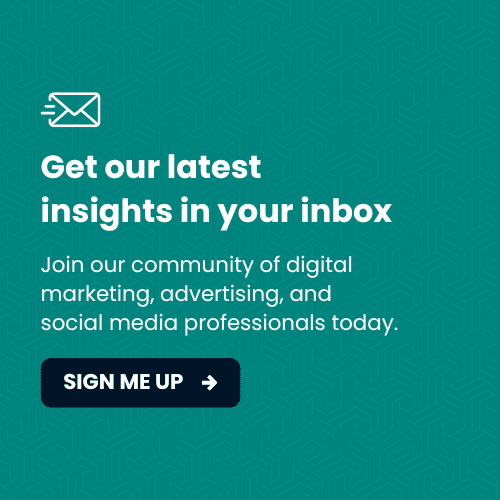Ad blindness, or banner blindness, can demoralize a marketing team as it causes ROI to sink ever lower. Worse, many marketers are unaware of its effect, or else they underestimate it. But if marketers are unaware of the problem, how can they hope to fix it?
Fear not. Over the next few posts, we’ll tackle this nefarious effect, detailing concrete strategies you can put into practice right away.
In this post, we’ll lay the groundwork for combating ad blindness, beginning with an exploration of the effect’s basis in human psychology. Let’s get started.
The Psychology of Ad Blindness – Laying The Foundation
Past marketers were familiar with the foe that was ad fatigue. In the early years of radio, for instance, when families gathered around their set to listen to theatrical presentations such as 15 Minutes With Bing Crosby or 20 Questions, they tended to listen raptly to the ads as well. But over time, those same families began to tune the ads out.
You see, the novelty had worn off, and consumers—some more than others—came to resent the advertising. This was a problem in the early days because moms and dads would only gather around the radio when a major production was scheduled to broadcast. When radio gave way to TV, this effect was somewhat less important. Messaging could still infiltrate the subconscious minds of viewers who weren’t actively listening to the ads. This is why the jingle became a go-to tool for marketers.
The bottom line is that ad fatigue is nothing new. The modern version of ad fatigue, ad blindness, or banner blindness, was reported as early as the late ‘90s. Back then, heatmap analysis yielded strong evidence that consumers would become indifferent to banners, even if those banners did not contain marketing messages.
Researchers found that, over time, participants’ eyes would glance over the banners, where in the early phases of the study, those same participants would linger over the boxes. As frustrating as ad blindness may be for marketers, it’s important to keep in mind that the underlying mechanism of ad blindness is a function of survival.
The brain is an energy-hungry organ, and much of its energy budget is dedicated to analyzing the environment. Think back to a time where you had to drive somewhere unfamiliar. It’s likely that the way there seemed longer than the way back. This is because as you drive to somewhere new for the first time, your brain is working overtime, taking in the sights, sounds, and smells. Partly, it’s doing this so it can find potential threats in the environment.
But on the way back, your brain drops back a gear, so to speak, since it’s already familiar with the route. It’ll still actively look for threats, but it’s no longer analyzing every bend in the road.
We can apply the same logic to Internet users as they browse websites. When they first encounter banners, they’ll analyze the banner to see if these elements contain useful information. Eventually, the process becomes automatic, or subconscious, and may look something like this:
Nope, ad. Nope, ad. Nope, ad. Nope, ad.
According to the paper, Eye Movements When Viewing Advertisements, by Emily Higgins et al., from the journal Frontiers In Psychology, each such assessment takes only 225 milliseconds.
The brain—quite automatically—comes to associate banners, square boxes and other angular page elements with ads. Consequently, the brain filters them out. This phenomenon is a by-product of our need to survive in a harsh environment. After all, if a hunter/gatherer had to consciously analyze every aspect of their environment, they wouldn’t get much done, would they?
Unfortunately for marketers, the tendency to ignore banners and boxes extends to text as well. Over time, the brain of the average consumer will begin to filter out text ads, too. A user’s eye will simply skip right over them.
The following, written by researchers Detweiler and Omanson, may have been true in 1996, but no longer:
“In general, the larger an item is, the greater its perceived visual importance and likelihood of attracting attention. Make sure that items of greatest importance are easy to see, and clearly distinguished from other items.”
While this advice is outdated, it serves to illustrate that marketers underestimated the effect of ad blindness, possibly assuming that the Internet, being novel, would be immune.
Today, irrelevant, large visual elements often go ignored. In the next section, we’ll cover methods to overcome ad blindness.
Overcoming Ad Blindness – First Steps
A comprehensive strategy for overcoming ad blindness involves five stages:
- Consider what the customer wants and what they need – and focus on that.
- Use design appropriately so you can attract attention in a non-confrontational and non-aggressive way.
- Ensure that your ads are relevant.
- Use interactive tools whenever possible.
- Use social media marketing, influencer marketing, and content marketing to bolster and complement your direct marketing efforts.
We’ll look at each of these in more detail in future posts, but for now, let’s touch briefly on each.
1. Think About Customer Needs
If you have a product that is a good fit for the customer, and the ad for the said product is displaying on a relevant page, you’re already in good shape. There’s no need to display flashy banners or use annoying marketing tactics. There’s a good chance that the prospect will ignore these elements. Worse, they may leave the page they’re on to seek a less hostile environment. Consumers don’t want to be accosted by blatant advertising.
But they might need your product. So don’t blow your first impression. Your best bet is to make your case with strong, but unobtrusive copy, and then get out of the way.
2. Utilize Appropriate Design
We’ll cover design elements in more detail in a future post, but for now, here’s a tip. Certain design elements, such as faces and eyes, have been shown in study after study to attract more attention than other elements. In fact, we all have a special set of neurons with just one job: analyze and recognize faces. Causing these neurons to fire is one way to increase the odds that a prospect will interact with your ad.
3. Be Relevant
It’s better to deliver fewer, but more relevant ads, than several ads that are only loosely targeted. As you know, poor targeting will result in a low click-through rate, which is a waste of money. What’s more, poor targeting is a sure-fire way to come up against ad blindness.
Action tip: always use the analytics tools made available by your advertising platform. With these tools, you can better segment your target audience, which will result in a higher click-through rate and increased ROI.
People don’t want to be advertised to. To earn a click, you must break through their initial resistance. Relevancy is your main ally here.
4. Use Interactive Tools
We’ve come a long way since the late ‘90s. Today, we have at our disposal interactive tools with which we can deliver engaging experiences. These tools are effective at gaining consumer attention, and sometimes, they even go viral. Examples include:
- Calculators
- Quizzes
- Questionnaires
- Chat bots
These tools work especially well if you have your own app. With an active user base, on your own platform, you have a captive audience that is more likely to engage with your interactive content.
5. Be Social
Consumers care about the advice and opinions of others. After all, we’re social beings. You can augment your direct marketing efforts with clever content marketing, influencer marketing, etc. What’s more, throughout this process, you can establish and foster relationships with brand ambassadors. These brand ambassadors will then sing your praises to their followers on social media. This leads to lower reliance on direct advertising via increased word-of-mouth.
This roundabout way to combat ad blindness can be quite powerful.
Additionally, social media platforms like Facebook allow you to create groups with which you can build up a fan base. While these people interact with you on social platforms, you’re exposing them to your brand. Once brand recognition sets in, they’ll prove more receptive to your advertising.
If you have brand ambassadors, these super fans will expose their own followers to your brand, and then the same effect applies.
Summary
Combating ad blindness in the modern era comes down to being sensitive to the customer’s needs, being relevant and utilizing modern tools. If you tackle each issue one at a time, you can make steady progress in your quest to increase ROI. Stayed tuned. In future posts in this series, we’ll explore the above tactics in more depth.



